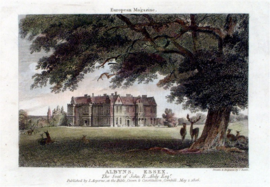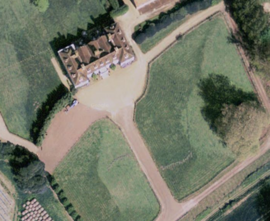Difference between revisions of "MRP: Buildings"
| Line 65: | Line 65: | ||
== KENT == | == KENT == | ||
---- | ---- | ||
| − | |||
| − | |||
| − | |||
| − | |||
| − | |||
| − | |||
| − | |||
| − | |||
| − | |||
| − | |||
| − | |||
| − | |||
| − | |||
| − | |||
| − | |||
| − | |||
| − | |||
| − | |||
| − | |||
| − | |||
| − | |||
| − | |||
| − | |||
'''James Master's house, Yotes Court, Kent''' | '''James Master's house, Yotes Court, Kent''' | ||
Revision as of 06:27, August 26, 2011
Contents
Buildings
LONDON
The Corner or Old Corner (?of Old Bailey), London
Elizabeth Dalyson's lodgings, Throgmorton Street, London
Sir George Smith's house, Throgmorton Street, London
Grays Inn Chambers, London
ENVIRONS OF LONDON
William Ryder's house, Bethnal Green
St. John Street, Clerkenwell (Sir Maximilian Dallison)
St. John Street, Clerkenwell (Lady Oxenden)
DENBIGHSHIRE
Myddleton family, Chirk Castle, Denbighshire
ESSEX
Sir Robert Abdy's house, Albyns, Stapleford Abott, Essex
KENT
Broome Park
- Dixwell, later Oxenden family house, Broome Park, Kent
Deane
- Oxenden family house, Deane, Deane House, or Deane Park, Kent
The Hamptons
- Stanley, later Dalyson house, Hamptons, Kent
Langdon
- Richard Master's & later James Master's house, East Langdon, Kent
Maydekin
- Henry Oxinden's house, Maydekin, Barham, Kent
Unnamed house in Plaxtol
- Thomas Stanley's house, Plaxtol, Kent
Stonepitt
- Sir Thomas Piers' house, Stonepitt, Kent
Yotes Court
- James Master's house, Yotes Court, Kent
DENBIGHSHIRE
Myddleton family, Chirk Castle, Denbighshire
Sources
ESSEX
Sir Robert Abdy's house, Albyns, Stapleford Abott, Essex
Sir Robert Abdy purchased the manor and manor house of Albyns in 1654 from Baron Coleraine for £5,360. The house was demolished in 1954, but at Abdy's time was what the VCH: Essex describes as a "very fine manor house," which incorporated parts of a smaller, earlier C16th house. A survey of the building exists, carried out by the Royal Commission on Historical Monuments, 1920. The house was brick-built, enclosing a courtyard on four sides. The VCH, drawing on the RCHM, describes it as "entirely of the King James Gothic," with mullioned and transomed windows, and two story bays on three sides. There was a long gallery on the first floor of the west wing, with fine panelling and an elaborate chimney. The quality of fittings and plasterwork was high. "The shields in the spandrels of the older fireplaces were painted with the date 1654 and the initials A B K (for Robert and Katherine Abdy) and the panelling bore the arms of Abdy and Gayre." There is a detailed estate map of Albyns from the period of its acquisition by Sir Robert Abdy, the work of John Kersey. "It shows the layout of the grounds with stables and a dovehouse to the east of the mansion and a straight avenue leading south from the main entrance."Sources
XXXX, A new display of the beauties of England, 1st vol., 3rd ed. (London, 1776), p.39
Royal Commission on Historical Monuments (XXXX, 1920), p. ?
Powell, W.R., 'Stapleford Abbots: Introduction', A History of the County of Essex: Volume 4: Ongar Hundred (1956), pp. 222-223
Powell, W.R., A History of the County of Essex: Volume 4: Ongar Hundred (1956), plan of Albyns, Stapleford Abbots, from an estate map of 1654 (Essex Record Office D/DC 27/1121), p. 226
Essex Archives: D/DAy Records of the Abdy family of Albyn, Stapleford Abbots and Felix Hall, Kelvedon
Essex Archives: D/Day E3 Rents, Manor of Albyns, Garnish hall and Barndon Hall, c. 1640
KENT
James Master's house, Yotes Court, Kent
James Master built Yotes Court in 1659, pulling down the previous mansion on the site, which had been the property of his step-father Sir Thomas Walsingham. In 1828 the property was described in some detail: “It consists of two stories surmounted by a high roof, with dormer windows, and is built of brick, with stone quoins and dressings: a small Corinthian porch opens to a Hall fifty-eight feet long by nineteen feet wide; having on the right, a Dining-Room, and on the left of the entrance, a Drawing-room. The whole of the grounds comprise about one thousand acres, of which the house, garden, and shrubberies, immediately adjoining, occupy six acres; the water in the park, from whence all the ponds in the neighbourhood are fed, extends over five or six acres, and there are about three hundred acres of cover. From the principal entrance to Yotes Court, in the Mereworth Road to Forge Gate, is a beautiful drive of nearly a mile.” An 1889 Order of the Land Commissioners schedules the Yotes Court estate, then owned by Viscount Torrington, and describes it comrpising nine hundred and forty acres, which the schedule broke into thirteen blocks, with land in both the parishes of Mereworth and West Peckham. However, no information is available on the size of the estate at the time of the construction of Yotes Court.
Sources
Text
‘The expense-book of James Master, pt. II, A.D. 1655-57, Mrs. Max Dalison transcribed, Canon Scott Robertson, Archaeologica Cantiania, vol. 16 (London, 1886)
‘Expense-book of James Master, pt. III, A.D. 1658-1663, Mrs. Max Dalison transcribed, Canon Scott Robertson, Archaeologica Cantiania, vol. 17 (London, XXXX), pp. 321-352
‘Expense-book of James Master, Esq. Pt. IV’, Archaeologica Cantiania, vol. 18 (London, XXXX)
'Scheduling of Yotes Court Estate' (XXXX, 1889)
‘The life of James Master,’Archaeologica Cantiana, vol. 18 (London, XXXX), pp.157-168
J.P. Neale, Views of the seats of noblemen and gentlemen, in England, Wales, Scotland, and Ireland , vol. 4 (London, 1828), p. unnumbered
Images
'Yotes Court' in J.P. Neale, Views of the seats of noblemen and gentlemen, in England, Wales, Scotland, and Ireland , vol. 4 (London, 1828), p. unnumbered
Thomas Stanley & Maximilian Dallison house, The Hamptons, West Peckham, Kent
This house was leased by Thomas Stanley to Elizabeth Dalyson, following the signing of a marriage contract between his daughter, Frances, and Elizabeth's son, Maximilian. The property had come into the Stanley family through the marriage of Thomas' father, XXXX Stanley, to XXXX of the Hamptons, Kent. Nothing is known of the building history.
Edward Hasted wrote in 1798: “The seat of Hamptons, now almost in ruins, stands near the east side of this stream, in a wild gloomy situation, and at a small distance, that of Oxenhoath, an antient brick building, situated on a rise of ground, having a most extensive prospect over the Weald, and again to the hills north-eastward, the ground about it is finely wooded, and is the greatest part of it exceeding rich pasture.”
The original Hamptons was apparently destroyed by fire in 1883. Another building, also titled Hamptons in West Peckham has been listed by English Heritage as Grade II. The listing states that this house was being built in 1813.
No surviving image or plan of the house has been found.
Sources
Hasted, Edward : 'Parishes: West Peckham', The History and Topographical Survey of the County of Kent: Volume 5 (1798), pp. 56-70
Hull, Felix, Guide to the Kent archives (XXXX, 1958), p. 174
- English heritage listing: the Hamptons
‘Letters of Thomas Stanley of Hamptons’ in Archaeologia cantiana, vol. 17 (London, 1887)
Dixwell family house, Broome Park, Kent
Sources
CKS-U2691 Correspondence from Lord Kitchener concerning Broome Park, Barham (1911-1918)
Dallison family house, Bishops place or palace, Halling, Kent
The Bishop's Palace or Place lay in the centre of the village of Halling off what is now called Ferry Road. It bordered the northern bank of the River Medway, and overlooked marshes to the south. Presumably a ferry plied linked the two banks of the Medway at this point, since the modern river is particularly narrow at this point, as it turns with a sharp kink on the way from Snodland towards Chatham and Rochester.
A series of chancery records in the first half of the seventeenth century chart the financial problems of the - Dallison family as it struggled with the lease on the Bishops Palace and associated lands. The Palace and lands were held by lease from the Bishop of Rochester.
See - Map of North Weald Houses
Sources
C 2/Eliz/D1/45, C 2/Eliz/D2/45, C 2/Eliz/D5/59, C 2/Eliz/D6/57, C 9/49/48
Letter from Henry Oxinden (?of Barham) to John Warner, Bishop of Rochester, April 17th 1643, MS. 28,000, f. 243, printed in Dorothy Gardiner, The Oxinden and Peyton Letters, 1642-1670, being the Correspondence of Henry Oxinden of Barham, Sir Thomas Peyton of Knowlton and Their Circle (London, 1947), pp. 14-15

